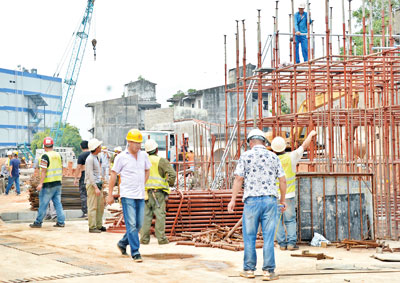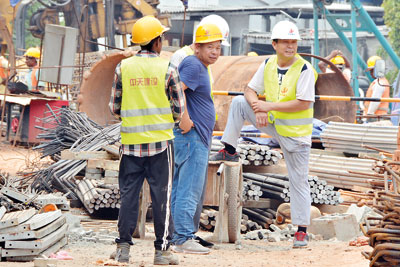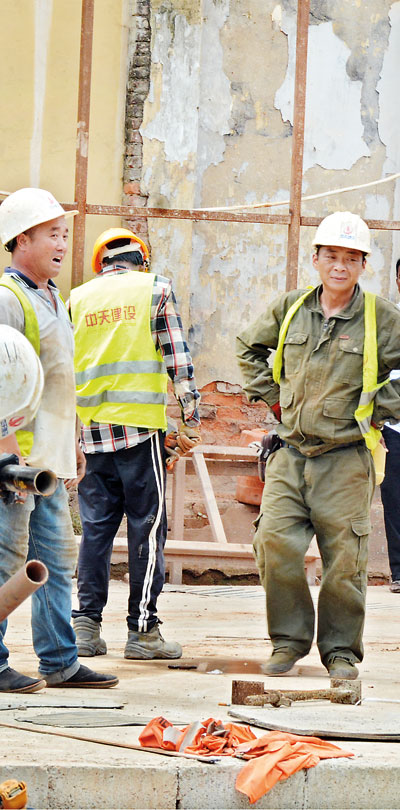News
‘Mason baas’ label drives youth away from building boom
The government’s decision not to bar youth from becoming trishaw drivers has crushed the hopes of the construction industry, which wants young people to get out of three-wheelers and boost the painfully thin ranks of building industry workers.

Owing to the shortage of skilled construction workers, many firms are compelled to explore foreign labour sources. Pix by Priyantha Wickramarachchi and Nissanka Meegoda
“There is a huge demand for construction workers in the country. The ration of skilled to unskilled workers is 1:16,” Tertiary and Vocational Education Commission (TVEC) Chairman Professor Dayantha Wijesekera said.
“Young people,” Prof. Wijesekera said, “would rather drive a three-wheeler than work on a construction site. Most of them are dropouts from school and those who have failed their Ordinary Level exams. They pressure their parents to finance the lease of a three-wheeler and spend their time on the roads, waiting for a hire.”
“They have an attitude problem and they think working on a construction site is beneath their dignity. We have to change this thinking and remove the stigma attached to the job,” he said.
The construction industry has been pushing for the national policy on the age limit for three-wheeler drivers to be implemented so that more people will join the industry.
Last week, however, Cabinet rescinded Motor Traffic Act Regulation No.01 of 2017 permitting only those over 35 years of age to be issued with driving licences, saying the law would hit the livelihood of millions of people who depended on trishaw driving.
According to Construction Industry Development authority (CIDA) the burgeoning construction industry needs at least 60,000 unskilled workers a year but only around 20,000 people pass out of the vocational training schools conducted by CIDA and the National Apprentice & Industrial Training Authority (NAITA) and other vocational training institutes run by charity organisations.
The total requirement is more than 1,565,000 skilled workers and 400,000 assistants as well as others to fill technical jobs.
Eventually, Sri Lanka will have to import workers from neighbouring countries, the TVEC warned.
A silver lining in the dark cloud is that some Colombo schools have risen to the need and have begun to include vocational studies in mainstream study, Mr. Wijesekera said, citing a girls’ school in Colombo 7 and urging others to follow this example.
The TVEC is hoping to attract students to the construction industry by providing them with a National Vocational Certificate, NVQ1 progressing to NVQ4, and thereafter a diploma and a degree. Candidates do not need a pre-qualification and can even be dropouts from school.
“They can achieve excellence in the industry,” Mr. Wijesekera said. “Even fisherfolk joined after the 2004 tsunami and obtained certification in the construction industry, and many are working in the trade,” he said.
Making schooling compulsory up to the age of 12-13 years would help youth to move into vocational studies, Mr. Wijesekera said: “After the Ordinary Level, those who do not fare well can be encouraged to take up vocations such as electrical work, carpentry and plumbing.”
The problem is in the label “mason baas”, commented Vocational Training Authority (VTA) Chairman Ravi Jayawardena.
“Today’s youth do not want to be called that. Even boys and girls in rural Sri Lanka are reluctant to join because of the labelling.
“They think the job is beneath their standards and that there is no dignity in it. This thinking must be changed. Employers and others should give them due recognition and respect. The division of labour has to be abandoned. Only then we can pass this hurdle,” Mr. Jayawarena said.
Around 1.3 million three-wheelers ply the roads, driven, for the most part, by youth who do not pursue education or acquire new skills. “They park their vehicles and wait in the sun for a hire,” Mr. Jayawardena said. “These youth can easily be misled into taking drugs and joining underworld gangs.”
To attract people into the industry it is important that fair wages be given to unskilled workers, Mr. Jayawardena said.
“Most workplaces pay low wages and tend to continue to pay youth apprentice wages even after their period of apprenticeship. This dampens the hopes of the youth, who want to earn higher wages.”
The VTA Chairman said that even when workers present an NQV certificate or qualifications from other vocational institutes, most worksites employ them on low wages. “They quit and look for other jobs despite the training they have obtained,” he said.
“We are now planning to hold discussions with the Labour Department on introducing a fixed salary scale. With no regulation and no salary scale young workers have no motivation to climb up the ladder.”
Currently, depending on skill and hire needs, contractors decide the daily wage, offering Rs. 2,500 to a skilled worker and Rs.1,800-2,000 to unskilled workers.
The Construction Industry Development Authority (CIDA) has started several programmes in collaboration with NAITA to encourage youth to enter the industry through jobs in the Ministry of Housing’s 500-village Gam Udawa programme.
Gam Udawa Director-General, architect Hemantha Balachandra, said these youth will be paid an allowance of Rs.10,000 a month for three months during the training period and be given uniforms. At the end of it they are paid Rs.15,000 a month, and once they acquire the NVQ certificate they are absorbed into the project on a permanent basis, earning up to Rs. 40,000-60,000 depending on their skills.
“We see more interest among the rural youth because they get paid during their apprenticeship period,” Mr. Balachandra said. “These youth come from poverty-stricken homes and cannot exist for long periods without wages.”
The Assistant Commissioner of the Labour Standard Division, S. Walpita, says minimum wages for unskilled construction workers have, in fact, been set. She said construction workers come under the Engineering trade and the basic wage of unskilled workers is Rs. 12,000 while that of a semi-skilled worker is Rs.12,500 and Rs. 13,000 for a skilled worker. In addition, a budgetary relief allowance of Rs. 3,500 is a mandatory payment for all.
The industry calculates the daily wages of workers based on this scale, Ms. Walpita said. She said that the Wages Board has, since May 2018, been working on a plan to revise the scales. “Work is in progress to revise 44 categories of skilled and unskilled workers but the engineering trade is not being reviewed,” she said. The revision will be announced by December 2018, she said.

